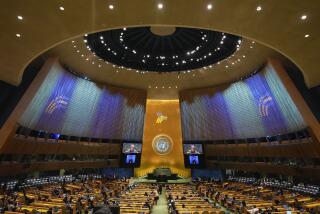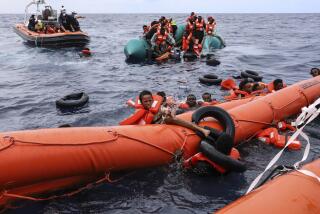Europe Security Pact Approved : Soviets Agree to Allow Automatic Inspections of Troop Maneuvers
- Share via
STOCKHOLM — A historic agreement to reduce the risk of war in Europe through mandatory observation, aerial inspection and advance notification of all major military activities from the Atlantic to the Ural Mountains in the Soviet Union was concluded here Sunday night by the 35 states that participated in the 1975 Helsinki Accords.
In the first East-West security agreement to be negotiated since the never-ratified second strategic arms limitation agreement of 1979, the Soviet Union accepted for the first time the right of a foreign power to carry out automatic on-site inspection of conventional military forces deep in its national territory.
From Jan. 1, 1987, all participating nations will have the automatic right to send military observers to watch large maneuvers and exercises in any other state anywhere in Europe--except Albania, which is not involved in the agreement.
Formal Conclusion
After 33 months in Stockholm, the Conference on Security and Confidence-Building Measures and Disarmament in Europe will conclude formally today with a round of brief speeches in a final plenary session. Long months of tedious inertia, marking time and getting nowhere, gave way in the last three weeks to a flurry of hard bargaining and detailed technical negotiation that has produced an agreement that well exceeds the best hopes of January, 1984, when the conference began.
Ambassador Robert L. Barry, head of the U.S. delegation, praised the outcome as “a good, solid confidence-building regime which should make the European security situation more stable and secure, an important practical move toward reducing the risk of military confrontation.”
Barry’s Soviet counterpart, Ambassador Oleg A. Grinevsky, told a news conference: “Of course I am satisfied, and I’m sure that everybody who took part in this very difficult negotiation is satisfied professionally, emotionally and as human beings. Of course, I’m sorry we could not manage to do more. But I think that in the present situation, this is the maximum of what was possible.”
Grinevsky said that Soviet leader Mikhail S. Gorbachev had promised more openness, “and this is a real step with our inspection agreement, and I am very proud that my country has been a leader in concessions to common sense and peace.”
Canadian Ambassador W. T. Delworth said he is convinced that the outcome “will change the shape of things to come in a very meaningful way, and that I think is a huge success.”
Improvement Over Accords
The new agreement is a considerable improvement on provisions contained in the original 1975 Helsinki Accords. This agreement, adopted Aug. 1, 1975, at a conference in Helsinki, Finland, left compliance voluntary but urged participating states to inform their neighbors about any maneuvers involving more than 25,000 men and to invite foreign observers to attend. Compliance with this voluntary program in the last 10 years has varied from spotty to non-existent.
Under the Stockholm agreement, a new system of mandatory exchange of military information and mutual observation will go into force in January in which all participating countries will share.
Final sticking points were resolved Sunday morning in a series of meetings between Barry and Grinevsky and in drafting sessions of small groups of North Atlantic Treaty Organization and Warsaw Pact ambassadors.
For the last three days, the key issue East-West issue has been the “threshold” figure on the size of military maneuvers for which advance notification must be given and outside observers must be invited. In the end, NATO gave way, accepting figures higher than it had been pushing for, while the Soviets came down slightly. NATO military advisers do not believe the compromise will materially affect the operation of the agreement.
Under the compromise, all upcoming military maneuvers involving at least 13,000 troops or 300 tanks will have to be disclosed 42 days in advance, and all maneuvers involving more than 17,000 men will automatically be open to observers from any of the participating states.
Western military experts expect there will now be notification from the Warsaw Pact of about 80 maneuvers a year, of which probably 10 to 15 will automatically be open to observers on the basis of the 17,000-men threshold.
In addition, at the insistence of Norway, which has a special problem of defense of the Arctic region in the face of massive Soviet forces on the Kola Peninsula, each side will be required to give notice of any amphibious landing exercises involving up to 3,500 men--and open up for inspection all amphibious exercises of 5,000 men or more.
In addition to on-the-spot ground observation of military maneuvers, the agreement provides for a completely new system of automatic aerial inspection of any suspicious military activities, such as unusual troop concentrations or sudden reinforcements in a particular area, about which no notification has been given.
Any state in possession of intelligence information on such activities will have the right to demand an aerial inspection of the area, and the state where the activity is supposedly taking place is required to provide an aircraft within 12 hours.
Such inspections will be limited to three per year over any one country, and each inspection must be by a different power. Many hours were spent negotiating the exact procedures for these inspections to ensure that if the United States, for example, wants to fly over the Soviet Union, its military inspection team will be flown exactly where it wants to go and will see everything it wants to see.
‘Constraints Provision’
Finally there is a so-called “constraints provision” in the document that requires any country to give at least two years’ notice of any planned maneuver involving 75,000 men and at least one year’s notice of exercises involving more than 40,000 men. This provision is aimed at reducing the risk of any massive buildup of troops, going well beyond the normal pattern of small maneuvers. If notification has not been given long in advance, such large-scale exercises are prohibited.
About the only main objective sought by the United States and its NATO allies and not obtained was an agreement to exchange “status information” each year on military spending, numbers and locations by unit of troops in place in Europe and other such data, which is largely known to the major intelligence services anyway.
More to Read
Sign up for Essential California
The most important California stories and recommendations in your inbox every morning.
You may occasionally receive promotional content from the Los Angeles Times.









